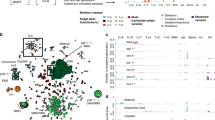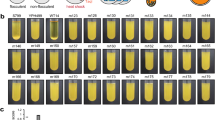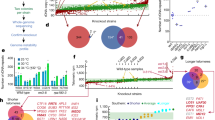Abstract
To identify environmental carcinogens there is a need for inexpensive and reliable short-term tests1, but certain human or animal carcinogens are persistently undetectable as mutagents with the Antes assay2–5 or with other short-term tests currently in use6,7. Thus there is a need for short-term tests which detect carcinogens missed by the Ames assay1. Because of the association of carcino-genesis with genome rearrangement8–12, a system screening for intrachromosomal recombination resulting in genome rearrangement has been constructed in Saccharomyces ceremstae13. Evaluation of this system shows indncibility by a variety of carcinogens3–7 not detectable by the Ames assay or various other short-term tests. In the light of these results it is tempting to speculate that 'nongenotoxic carcinogens' are in fact genotoxic but, in the past, the tools to measure the genetic alterations they induce have been inappropriate.
This is a preview of subscription content, access via your institution
Access options
Subscribe to this journal
Receive 51 print issues and online access
$199.00 per year
only $3.90 per issue
Buy this article
- Purchase on Springer Link
- Instant access to full article PDF
Prices may be subject to local taxes which are calculated during checkout
Similar content being viewed by others
References
Lave, L. B. & Omenn, G. S. Nature 324, 29–34 (1988).
Ames, B. N., McCann, J. & Yamasaki, E. Mutat. Res. 31, 347–364 (1975).
McCann, J., Choi, E., Yamasaki, E. & Ames, B. N. Proc. natn. Acad. Sci. U.S.A. 72, 5135–5139 (1975).
McCann, J. & Ames, B. N. Proc. natn. Acad. Sci. U.S.A. 73, 950–954 (1976).
Flora, S. D., Zanacchi, P., Camoirano, A., Bemecelli, C. & Badolati, G. S. Mutat. Res. 133, 161–198 (1984).
Sivak, A., Goyer, M. M. & Ricci, P. F. in Nongenotoxic Mechanisms in Carcinogenesis, 1–8 (Cold Spring Harbor Laboratory, New York, 1987).
De Serres, F. J. & Ashby, J. Prog. Mutat. Res. 1, (1981).
Mara, J. L. Science 218, 983–985 (1982).
Klein, G. Nature 294, 313–318 (1981).
Pall, M. L. Proc. natn. Acad. Sci. U.S.A. 78, 2456–2468 (1981).
Cairns, J. Nature 289, 353–357 (1981).
Wintersberger, U. Naturwissenschaften 69, 107–113 (1982).
Schiestl, R. H., Igarashi, S. & Hastings, P. J. Genetics 119, 237–247 (1988).
Ricci, P. F. & Melton, L. S. Envir. Sci. Technol. 19, 437 (1985).
Hansen, M. F. & Cavanee, W. K. Cell 53, 172–173 (1988).
Ponder, B. Nature 335, 400–402 (1988).
Schiestl, R. H. & Prakash, S. Molec. cell. Biol. 8, 3619–3626 (1988).
International Agency for Research on Cancer: Monographs on the Evaluation of Carcinogenic Risk to Man Vols. 1–31 (IARC Lyon, 1973–1983).
Clapp, N. K. Int. J. Cancer 12, 728 (1973).
Arcos, J. C. & Argus, M. F. Chemical Inducation of Cancer, Vol. 11 A and B, (Academic, New York, 1974).
Zimmermann, F. K. et al. Mutat. Res. 133, 199–244 (1984).
Ashby, J. & Tennant, R. W. Mutat. Res. 204, 17–115 (1988).
Handbook of Carcinogen Testing (eds Milman, H. A. & Weisburger, E. K.) (Noyes, New Jersey, 1985).
Zimmermann, F. K. in Cellular Systems for Toxicity Testing, 186–196 (Annals of the New York Academy of Sciences, 407 New York, New York, 1983).
Kroes, R. in Cellular Systems for Toxicity Testing, 398–408 (Annals of the New York Academy of Sciences, 407 New York, New York, 1983).
Willis, E. A., Weksberg, R., Tomlinson, S. & Lindahl, T. Proc. natn. Acad. Sci. U.S.A. 84, 8016–8020 (1987).
Fassullo, M. T. & Davis, R. W. Proc. natn. Acad. Sci. U.S.A. 84, 6215–6219 (1987).
Sherman, F., Fink, G. R. & Hicks, J. B. Methods in Yeast Genetics, A Laboratory Manual (Cold Spring Harbor Laboratory, Cold Spring Harbor, New York, 1986).
Nongenotoxic Mechanisms in Carcinogenesis (eds, Butterworth, E. B. & Slaga, T. J.), (25 Banbury Report, Cold Spring Harbor Laboratory, Cold Springer Harbor, New York, 1987).
Shinozuka H., Lombardi, B., Sell, S. & Immariano, R. M. Cancer Res. 38, 1092–1098 (1987).
Sittig, M. Handbook of Toxic and Hazardous Chemicals and Carcinogens (Noyes, New Jersey, 1985).
Author information
Authors and Affiliations
Rights and permissions
About this article
Cite this article
Schiestl, R. Nonmutagenic carcinogens induce intrachromosomal recombination in yeast. Nature 337, 285–288 (1989). https://doi.org/10.1038/337285a0
Received:
Accepted:
Issue Date:
DOI: https://doi.org/10.1038/337285a0
This article is cited by
-
Yeast-based genotoxicity tests for assessing DNA alterations and DNA stress responses: a 40-year overview
Applied Microbiology and Biotechnology (2018)
-
Fluorescence-based recombination assay for sensitive and specific detection of genotoxic carcinogens in human cells
Archives of Toxicology (2014)
-
Mouse models for induced genetic instability at endogenous loci
Oncogene (2003)
-
On the mechanism of UV and γ-ray-induced intrachromosomal recombination in yeast cells synchronized in different stages of the cell cycle
Molecular and General Genetics MGG (1995)
-
Involvement of the PS03 gene of Saccharomyces cerevisiae in intrachromosomal mitotic recombination and gene amplification
Molecular and General Genetics MGG (1994)
Comments
By submitting a comment you agree to abide by our Terms and Community Guidelines. If you find something abusive or that does not comply with our terms or guidelines please flag it as inappropriate.



